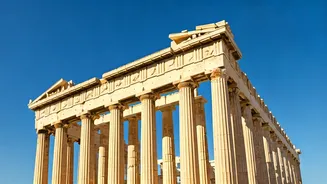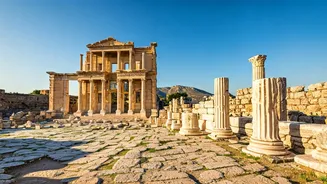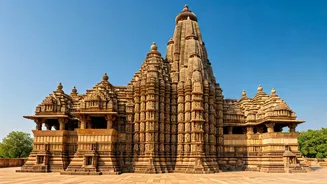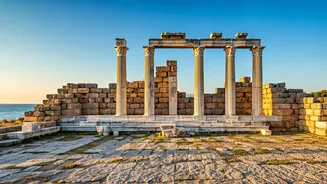The Acropolis, Athens
At the heart of Athens stands the Acropolis, a monumental complex that symbolizes ancient Greece's power and architectural prowess. Dominating the cityscape,
it features the Parthenon, a temple dedicated to Athena, the city's patron goddess. Constructed in the 5th century BC, the Parthenon's Doric columns and intricate sculptures are testaments to the skill of ancient artisans. The Acropolis also houses the Propylaea, the monumental gateway, the Erechtheion, with its iconic Caryatids, and the Temple of Athena Nike. Exploring the Acropolis offers a deep dive into classical architecture, history, and the profound impact of Greek civilization on the world. The site itself is a UNESCO World Heritage site, underscoring its global significance.
Delphi: The Oracle
Nestled on the slopes of Mount Parnassus, Delphi was an ancient religious sanctuary and the location of the Oracle of Delphi. People from across the ancient world visited Delphi to consult the Oracle, seeking prophecies and guidance on important matters. The Temple of Apollo was the heart of the sanctuary, with its ruins still conveying a sense of grandeur. Alongside the temple, the site includes a theater, a stadium, and numerous treasuries built by different city-states to display their wealth and commemorate victories. Delphi's strategic location and spiritual importance made it a central hub of ancient Greek culture and a significant influence in decision-making and religious life.
Knossos: Minoan Palace
On the island of Crete, Knossos stands as a remarkable testament to the Minoan civilization, flourishing around 2700-1450 BC. The Palace of Knossos, a complex labyrinth of rooms, corridors, and courtyards, is a testament to the Minoans' sophisticated urban planning and architectural innovation. The site features vibrant frescoes, depicting scenes of daily life, religious ceremonies, and bull-leaping, offering insights into Minoan society. The Palace's size and complexity suggest a centralized government and a highly organized society. Knossos also highlights the Minoans' influence on the wider Mediterranean world through trade and cultural exchange.
Olympia: Birthplace Games
Olympia is the birthplace of the Olympic Games, a Panhellenic festival held every four years to honor Zeus. The ancient site includes the Temple of Zeus, once housing a colossal statue of the god, as well as the Temple of Hera, the Palaestra, where athletes trained, and the stadium, which could accommodate tens of thousands of spectators. The Olympic Games, starting in 776 BC, were more than just athletic competitions; they were a religious and cultural event, promoting peace and unity among the Greek city-states. Exploring Olympia provides a glimpse into the values of ancient Greece, emphasizing physical prowess, competition, and the celebration of the human spirit.
Ephesus: Roman City
Ephesus, located in present-day Turkey, was a major ancient Greek city and later a prominent Roman metropolis. Flourishing under Roman rule, Ephesus featured impressive structures like the Library of Celsus, which housed a vast collection of scrolls, and the Temple of Artemis, one of the Seven Wonders of the Ancient World. The city's well-preserved ruins include a grand theater, where public events and performances were held, as well as elaborate public baths and houses with mosaic floors. Ephesus's strategic location as a trading center and port city made it a vibrant hub of commerce, culture, and religious diversity, attracting people from across the Roman Empire.
Mycenae: Citadel of Agamemnon
Mycenae, in the Argolis region, was a significant Bronze Age city, known for its powerful rulers and impressive fortifications. The archaeological site is famous for its massive Cyclopean walls, which supposedly were built by the mythical Cyclopes. Key features include the Lion Gate, the main entrance to the citadel, and the Treasury of Atreus, a large tomb showcasing advanced engineering techniques. Mycenae's association with figures like Agamemnon, the king who led the Greek forces in the Trojan War, adds to its historical mystique. Exploring Mycenae offers insights into the rise of the Mycenaean civilization and its role in Greek mythology and early history.
Ancient Messene
Ancient Messene provides a well-preserved example of a classical city, offering a detailed understanding of urban planning and everyday life in ancient Greece. Founded in 369 BC, Messene was designed to be a strong political and military center. The site includes a remarkably preserved theater, a stadium, fortifications, and residential areas. The city's structure illustrates the focus on public spaces and civic life. The detailed preservation of Messene provides valuable insights into the social, political, and cultural aspects of ancient Greek society, away from the more famous sites.
Meteora Monasteries
The monasteries of Meteora, perched atop towering rock formations, are a unique blend of natural beauty and human ingenuity. Constructed by monks seeking isolation, these monasteries were built from the 14th century onwards. The monasteries feature Byzantine architecture, with intricate frescoes, icons, and religious artifacts. The steep cliffs and restricted access once provided natural protection and a sense of spiritual remoteness. Meteora's location and stunning views make it a remarkable site, combining religious significance with unparalleled scenery. Visitors experience both architectural marvels and panoramic vistas of the Thessalian plain.













